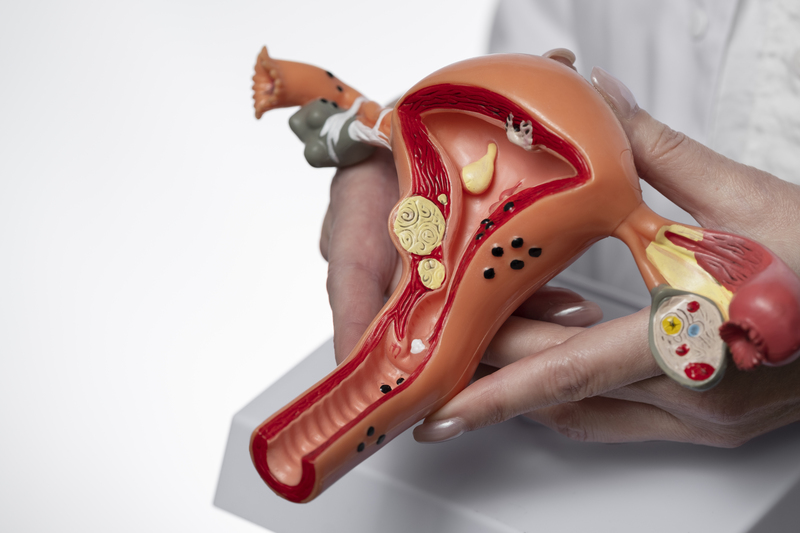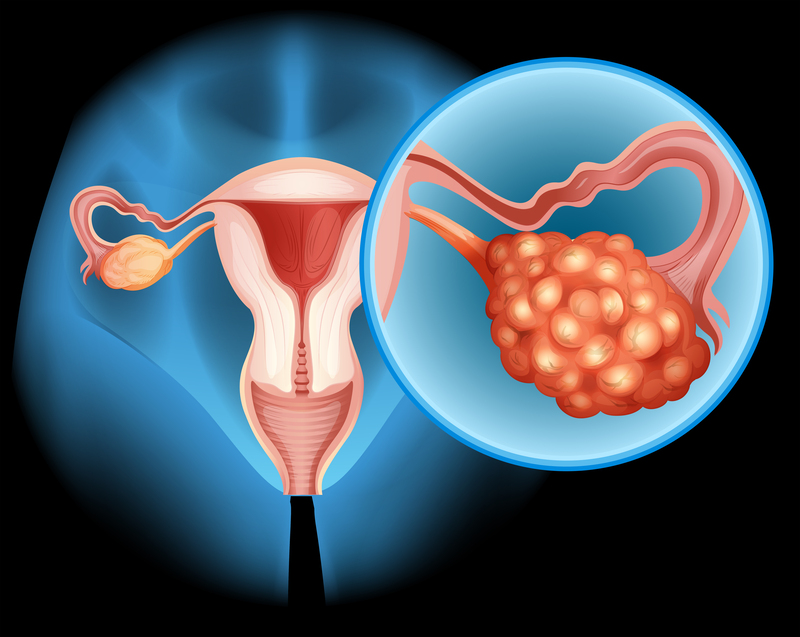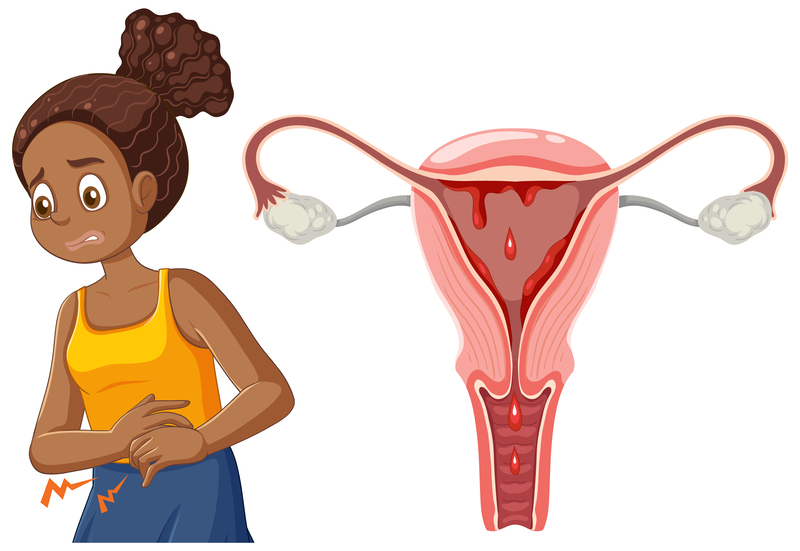Table of Contents
In the complicated web of gynecology and women’s health, ovarian endometrioma emerges as a noteworthy concern and is on the rise. These cysts, formed when endometrial cells i.e. the cells that comprise the inner lining of the uterus, abnormally grow in the ovaries and the areas adjacent to uterus i.e. the parametrium, can lead to pain during menses, discomfort and fertility challenges. Understanding the chocolate cyst of ovary causes, its symptoms, and treatment options is pivotal.

As per the WHO, approximately 10% (equivalent to 190 million) of women and girls in their reproductive years suffer with endometriosis worldwide. This enduring condition intertwines with a life-altering pain experienced during menstruation and on passing urine and motion, reduced sexual activity, painful bowel movements, or reduced or painful urination. Chronic pelvic discomfort, abdominal bloating, nausea, fatigue, and at times, emotional strains like depression, anxiety, and infertility, further characterize this complex ailment.
So as you can see, the impact is profound, underscoring the need for a deeper understanding of this condition to pave the way for more empathetic care and improved quality of life. So let’s get deeper into the problem to help eradicate the same.
Definition of Ovarian Endometrioma or Chocolate Cysts:
Ovarian endometrioma, a complex condition, arises when endometrial tissue, typically found in the uterus, implants and grows in the ovaries. Characterized by the formation of cysts filled with menstrual-like blood, this condition poses unique challenges in diagnosis and management.
Connection to Endometriosis:

A crucial aspect in understanding ovarian endometrioma is its strong association with endometriosis. As endometrial tissue proliferates outside the uterus, it often infiltrates the ovaries, leading to the development of these cysts. This intricate link underscores the need for comprehensive approaches in addressing both conditions.
Endometriosis is a condition in which the cells that line the innermost lining of uterus- the endometrium grow outside the uterus, it is most commonly seen in the ovaries- ovarian chocolate cyst or endometiomas.
Endometriosis has 3 components:
- Ovarian cyst/ chocolate cyst/ endometrioma
- Superficial endometriosis- found over the lining of the abdomen/peritoneum
- Deep infiltrating endometriosis- infiltrates deep into the viscera can affect the ureter (tubes carrying urine) or intestines or any other surrounding organs.
Risk Factors for Developing Ovarian Endometrioma:
Various factors heighten the risk of developing chocolate cysts. Women with a history of endometriosis face elevated susceptibility. Additionally, delayed diagnosis of endometriosis, nulliparity, and genetic predispositions contribute to the increased likelihood of ovarian endometrioma development. Recognizing these risk factors is pivotal for early detection and effective management of this intricate gynecological concern.
Understanding Causes of Chocolate Cyst of Ovary:

Several factors contribute to the development of these cysts, and a comprehensive exploration sheds light on their diverse origins.
- Hormonal Imbalances: Disruptions in hormonal balance emerge as a primary catalyst for the formation of chocolate cysts. Fluctuations in reproductive hormones create an environment conducive to cyst development, underscoring the intricate interplay between hormonal dynamics and the ovarian landscape.
- Menstrual Backflow: The phenomenon of menstrual backflow adds another layer to the causes of chocolate cysts. Retrograde menstruation, where menstrual blood flows backward into the pelvic cavity, becomes a contributing factor, fostering the formation of these cysts in the ovaries.
- Endometrial Tissue Implantation: The implantation of endometrial tissue outside the uterus extends beyond its natural boundaries, becoming a notable cause of chocolate cysts. This aberrant tissue growth attaches itself to the ovaries, forming cysts over time and accentuating the complexity of the condition’s origins.
- Inflammatory Responses: Inflammatory responses within the pelvic region also play a role in the development of chocolate cysts. Chronic inflammation can trigger the formation and growth of these cysts, emphasizing the significance of managing inflammation as part of a holistic approach to addressing this ovarian condition.
Ovarian Endometrioma Symptoms:
While some women experience no overt signs, others grapple with the enigmatic nature of these symptoms that necessitates a keen clinical eye for timely identification.

- Pelvic Discomfort and Pain: An unwelcome companion is persistent pelvic discomfort and pain. The implantation of endometrial tissue on the ovaries sparks inflammation, giving rise to sensations ranging from dull aches to sharp pains. Recognizing and addressing these ovarian endometrioma symptoms becomes paramount, offering a key to enhancing the overall well-being of those affected.
- Menstrual Pain – Dysmenorrhea: Under the impact of ovarian endometrioma, women often find themselves contending with dysmenorrhea – intense menstrual pain which affects their quality of life and daily activities. The presence of cysts further intensifies the already challenging menstrual experience, disrupting daily activities and prompting the need for personalized strategies to manage these discomforts.
- Irregularities in Menstruation: A distinctive chocolate cyst endometriosis symptom lies in the disruptions it introduces to the menstrual rhythm. Hormonal imbalances and the growth of chocolate cyst endometrioma collectively influence the menstrual cycle, leading to irregularities. Pinpointing and closely monitoring these variations plays a pivotal role in the diagnostic process.
- Navigating Fertility Challenges: The existence of these cysts can pose hurdles to reproductive processes, impacting ovarian reserve and potentially compromising fertility by affecting the oocyte or egg quality also. Addressing this facet necessitates a holistic approach, delicately balancing symptom management while preserving the aspirations for fertility.
Understanding Ovarian Endometrioma via a Comprehensive Diagnostic Approach
When it comes to diagnosing ovarian endometrioma, a skilled medical professional employs a multi-faceted strategy, integrating various tools and techniques. We are sharing the simple steps and digging deeper into the process:
Thorough Exploration of Medical History and Physical Examination:
To initiate the diagnostic journey, a detailed review of the patient’s medical history is conducted. This involves a meticulous investigation into chocolate cyst endometriosis symptoms, previous medical conditions, and relevant family history. A comprehensive physical examination follows, focusing on signs and symptoms that might indicate the presence of ovarian endometrioma.
Utilizing Imaging Studies for a Deeper Insight:

Medical experts leverage advanced imaging studies to gain a more profound understanding of the ovarian region. Techniques such as ultrasound and MRI play a pivotal role in visualizing the internal structures and identifying any abnormalities that may be indicative of endometrioma. These non-invasive methods provide valuable insights into the nature and extent of the condition.
- Chocolate Ovarian Cyst Ultrasound: Employing ultrasound allows for real-time imaging of the ovaries and surrounding structures. This dynamic approach enables clinicians to assess the size, location, and characteristics of potential endometriomas. Also to map the deep infiltrating component – nodules affecting the intestines or ureter.
- Magnetic Resonance Imaging (MRI) for Precision in Diagnosis: In certain cases, we as medical professionals opt for MRI(s) to attain a more detailed and precise assessment. MRI(s) offers high-resolution images, allowing for a comprehensive examination of the pelvic region.
- Laparoscopy, the Ultimate Standard for Definitive Diagnosis: While non-invasive methods provide valuable insights, laparoscopy stands as the gold standard for confirming the presence of chocolate cyst endometrioma. This surgical procedure involves the insertion of a thin, flexible tube equipped with a camera through a small incision. It offers a direct visual examination of the pelvic organs, enabling accurate diagnosis and, if necessary, immediate intervention.
Treatment Options for Chocolate Cyst Endometrioma:

- Conservative Approaches in Treatment: When addressing medical concerns, it is crucial to explore conservative treatment options. These methods prioritize non-invasive approaches, aiming to alleviate chocolate cyst endometriosis symptoms and promote natural healing. In the context of fertility issues, conservative strategies may involve lifestyle modifications, dietary changes, and specific medications tailored to the patient’s unique needs. It can be done in patients with no symptoms or no fertility issues.
- Surgical Interventions: In certain medical scenarios, surgical interventions become a viable course of action. The excision of all endometriosis in the body is the gold standard treatment for endometriosis. This involves skilled procedures conducted by infertility specialist(s) to rectify underlying issues. When it comes to fertility challenges, surgical interventions may target anatomical abnormalities or address conditions hindering reproductive health, offering a direct and impactful solution.
- Fertility Preservation Strategies: Preserving fertility is a significant consideration, especially in the face of medical treatments that may impact reproductive capabilities in chocolate cyst endometrioma. This involves proactive measures to safeguard eggs, sperm, or reproductive tissues for future use. Expert guidance and personalized plans play a pivotal role in navigating fertility preservation, ensuring individuals have options and hope beyond their current health challenges.
Chocolate Cysts Treatment – A Holistic Lifestyle Approach
We shall now share a lifestyle-focused strategy with dietary adjustments at its core.
- Dietary Changes and Chocolate Cyst Endometrioma: Opt for an anti-inflammatory diet rich in antioxidants, omega-3 fatty acids, and whole foods. These elements counteract inflammation, alleviating symptoms associated with chocolate cysts. Incorporating vegetables, fruits, and lean proteins fosters healing, contributing to overall reproductive health. Additionally, limiting processed foods and sugars further supports the body’s natural healing processes.
- Exercise and Physical Activity for Chocolate Cyst Endometrioma: Regular physical activity enhances blood circulation, reducing inflammation associated with the condition. Tailored exercises targeting the pelvic region contribute to strengthening pelvic muscles, offering relief from chocolate cyst symptoms. Incorporating moderate-intensity workouts, such as walking or yoga, proves beneficial.
- Stress Management Techniques and Chocolate Cyst Endometrioma: Chronic stress can exacerbate ovarian endometrioma symptoms, making stress reduction crucial. Techniques such as mindfulness meditation, deep breathing, and yoga promote relaxation, alleviating both physical and emotional strain. Stress reduction not only aids in symptom management but also supports the body’s natural healing processes.
Prevention Strategies for Chocolate Cysts:
- Hormonal Management in Prevention – Effectively preventing chocolate cysts involves strategic hormonal management. A tailored hormonal approach not only addresses existing concerns but also acts as a proactive shield against potential occurrences.
- Early Detection – Regular screenings and vigilant monitoring enable timely identification of potential issues, facilitating prompt intervention. Establishing a comprehensive routine for health check-ups, including specialized examinations, empowers individuals to detect any signs of ovarian endometrioma at an early stage. Early detection not only enhances treatment options but also significantly contributes to the overall prevention strategy, promoting long-term reproductive well-being.
In conclusion, it is paramount to recognize the importance of seeking medical advice when dealing with reproductive ovarian endometrioma. Professional guidance provides insights into personalized strategies, encompassing hormonal management and early detection methods of chocolate cyst endometriosis symptoms. So, remember, seeking medical advice is a proactive measure, and it plays a pivotal role in ensuring a healthier and more informed journey toward reproductive health. Your well-being is our shared priority!
Image Courtesy: Freepik
FAQs:
Yes, endometriomas can affect ovarian function and egg quality, leading to fertility issues. Early treatment can help mitigate the risks.
Pregnancy is possible with chocolate cysts, but they may reduce fertility. Treatment options like surgery can improve chances of conception.
Chocolate cysts are typically benign, but they can increase the risk of ovarian cancer in rare cases, making regular monitoring essential.
Yoga can help manage pain and reduce stress by improving blood flow and relieving pelvic tension, offering relief for endometriosis symptoms.
Endometriosis is a condition where uterine-like tissue grows outside the uterus, while ovarian cysts are fluid-filled sacs in the ovaries. Endometriomas are a type of ovarian cyst linked to endometriosis.
Symptoms include pelvic pain, painful periods, and discomfort during intercourse. Irregular menstruation and fertility issues can also occur.
Non-surgical options include hormonal therapies like birth control pills to manage symptoms. Lifestyle changes and pain relief medications may also help.




